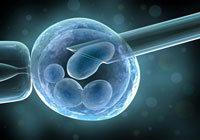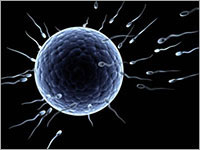The fertilised egg, now known as an embryo, develops in the fallopian tube for the first three days, then travels down into the uterus. By the fifth day it will become a blastocyst, a hollow ball of cells surrounding a cyst-like cavity. The blastocyst then breaks free from its shell, or hatches, and it is ready to adhere to the surface of the endometrium. It begins to secrete human chorionic gonadotrophin (hCG), a hormone that tells the corpus luteum to continue progesterone production. A home pregnancy test will detect hCGÂ when checked after a missed period. The egg maintains its ability to be fertilised for about 12 hours after ovulation. Sperm can remain viable in the cervical mucus for 48-72 hours or more around the time leading up to ovulation. |
 |
 FERTILIZATION AND IMPLANTATION
FERTILIZATION AND IMPLANTATION






